Gladiolus flowers enhance the elegance and liveliness of any garden or residence. These sought-after blooms present a wide array of hues and dimensions, rendering them a flexible selection for various environments. Within this comprehensive manual, we shall delve into the diverse classifications of Gladiolus, optimal nurturing practices, as well as effective techniques for planting and propagating them.
| Botanical Name | Gladiolus |
| Usage | Garden, cut flowers |
| Heyday | Summer |
| Color | Various |
| Origin | South Africa |
| Particularities | Tall spikes of flowers, requires well-draining soil |
Gladiolus – Care, Planting, Pruning
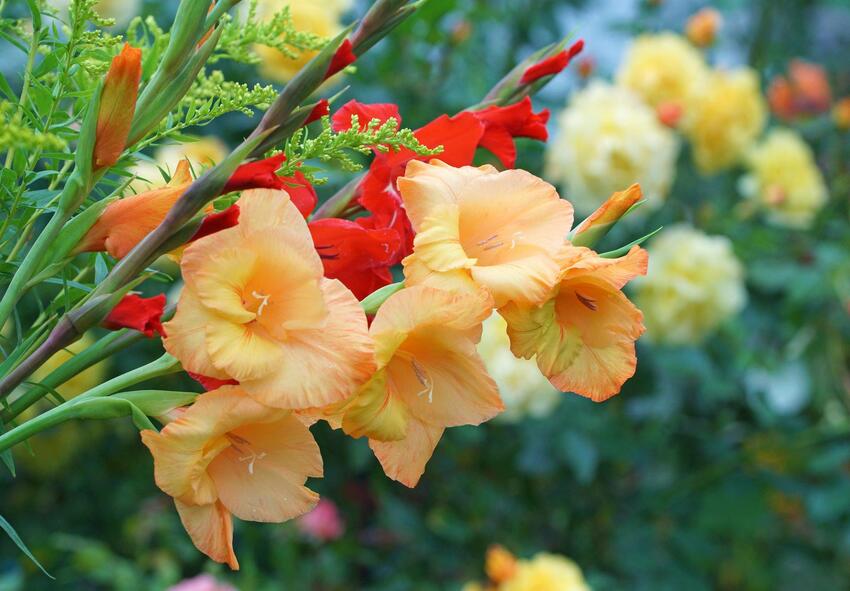
This particular portion of the guide encompasses the fundamental details pertaining to the care, planting, and trimming of Gladiolus flowers. It presents comprehensive instructions on watering, fertilizing, and pruning, accompanied by a step-by-step manual for planting and propagating. By adhering to these guidelines, you can guarantee the flourishing growth of your Gladiolus flowers, resulting in a captivating exhibition of vibrant hues and refined beauty.
Gladiolus: A Graceful and Vibrant Addition to Your Garden
Renowned for its exquisite allure and vivid hues, Gladiolus stands as a beloved flower among enthusiasts. Its popularity spans across gardens, floral compositions, and even as a cherished selection for cut flowers. Furthermore, Gladiolus serves as an excellent option for individuals seeking to infuse their homes with an element of refined splendor.
Basic Data and Characteristics of Gladiolus
Gladiolus belongs to the iris family and is classified as a genus of perennial cormous plants. While originating from South Africa, they have successfully been cultivated across the globe. Notably, Gladiolus flowers are distinguished by their impressive, towering spikes that can reach heights of up to 4 feet. Exhibiting a captivating palette, these blooms present a diverse spectrum of colors, encompassing shades such as pink, red, yellow, orange, and white.
| Variety | Height | Bloom Time | Color |
| Abyssinian | 61 cm | Summer | Orange |
| Hybridus | 122 cm | Summer | Various |
| Wild Gladiolus | 30 cm | Spring | Purple |
| Dwarf Gladiolus | 51 cm | Summer | Various |
Gladiolus Types – Unveiling the Differences

This section explores the different types of Gladiolus, including large flowering, miniature, and ruffled varieties. Each type has its unique characteristics, with large-flowering gladioli being the most common and miniature gladioli being a great choice for smaller gardens or containers. Ruffled gladioli, with their frilly double blooms, add a touch of elegance to any setting.
Exploring the Diversity of Gladiolus Types
Gladiolus is a genus of flowering plants that belongs to the family Iridaceae. It is known for its tall, elegant spikes of colorful flowers and is widely cultivated for ornamental purposes. Gladiolus comes in a wide range of varieties and hybrids, offering a diverse selection of colors, sizes, and forms. Let’s explore some of the popular types of gladiolus:
- Grandiflorus Group: This group consists of large-flowered gladiolus cultivars with showy blooms. They are known for their vibrant colors and are often used as cut flowers. Examples include ‘White Prosperity,’ ‘Red Beauty,’ and ‘Blue Isle.’
- Butterfly Group: The gladiolus varieties in this group have distinctive markings on their petals that resemble butterfly wings. They feature patterns of contrasting colors and intricate designs. Popular examples include ‘Butterfly,’ ‘Priscilla,’ and ‘Green Lace.’
- Primulinus Group: These gladiolus cultivars have smaller flowers with a delicate appearance. They typically bloom in a wide range of pastel shades, making them perfect for adding a touch of softness to gardens and floral arrangements. ‘Prins Claus,’ ‘Atom,’ and ‘Violetta’ are well-known examples.
- Nanus Group: The Nanus Group consists of dwarf gladiolus varieties that are shorter in stature compared to other types. They produce smaller flowers, but their compact size makes them suitable for containers, borders, or rock gardens. ‘Atom’ and ‘Robinetta’ are popular choices from this group.
- Byzantinus Group: This group includes gladiolus cultivars that are native to the Mediterranean region, particularly Greece and Turkey. They are known for their striking magenta-colored flowers and can add a bold burst of color to any garden. ‘Charming Beauty’ and ‘Ruby’ are representative examples.
- Primiola Group: These gladiolus varieties are known for their early flowering habit. They bloom earlier in the season compared to other types, making them suitable for regions with shorter growing seasons or cooler climates. ‘Boone,’ ‘Cynthia,’ and ‘Nymph’ are examples of early-blooming gladiolus.
- Collarette Group: The Collarette Group features gladiolus cultivars with distinctive flowers that have a ruffled appearance and a contrasting collar-like structure around the center. They are unique and eye-catching, with examples like ‘Plum Tart’ and ‘Rosie O’Grady.’
These are just a few examples of the diverse range of gladiolus types available. Whether you prefer large, showy blooms or delicate pastel shades, there is a gladiolus variety to suit every gardener’s taste. The cultivation of gladiolus provides a wonderful opportunity to create vibrant displays of color in gardens and enjoy their beautiful flowers as cut arrangements.
Understanding the Unique Characteristics of Each Gladiolus Type
Gladiolus is a popular flowering plant known for its tall spikes of colorful blooms. There are various types of gladiolus, each with its own unique characteristics. Here are some of the common types of gladiolus and their distinguishing features:
- Grandiflorus: This is the most commonly grown type of gladiolus. It features large, showy flowers with well-defined petals and a broad range of colors, including red, pink, orange, yellow, and white. The blooms are often marked with contrasting patterns or speckles. Grandiflorus gladiolus plants can reach heights of up to 5 feet (1.5 meters).
- Primulinus: Primulinus gladiolus is known for its smaller flowers and delicate appearance. The blooms are usually pastel-colored, with shades of pink, lavender, peach, and yellow being common. They have a softer, more rounded shape compared to the grandiflorus type.
- Nanus: Nanus gladiolus is a dwarf variety that typically grows to a height of 2 to 3 feet (0.6 to 0.9 meters). The flowers are smaller and more compact than those of other gladiolus types. Nanus gladiolus comes in a range of colors, including purple, pink, orange, and white.
- Primulinus Hybrids: These gladiolus hybrids are a cross between the grandiflorus and primulinus types. They inherit the large flower size of the grandiflorus and the softer colors and rounded shape of the primulinus. Primulinus hybrids offer a wide range of colors, including bi-colored and multicolored varieties.
- Butterfly Gladiolus: As the name suggests, butterfly gladiolus varieties have distinct butterfly-shaped flowers. The petals are split into two or more lobes, giving them a unique appearance. The colors are often vibrant and eye-catching, and they can have contrasting markings.
- Green and White Gladiolus: This type of gladiolus is prized for its unique color combination of green and white. The flowers may have green petals with white edges or white petals with green markings. They add a touch of elegance and freshness to floral arrangements.
- Fragrant Gladiolus: While not a specific type of gladiolus, some varieties are known for their delightful fragrance. These gladiolus flowers release a pleasant scent, adding an extra sensory element to their beauty.
It’s worth noting that there are countless gladiolus cultivars within each type, offering an extensive array of colors, patterns, and characteristics. The unique traits of each gladiolus type make them suitable for various gardening purposes, including cut flower arrangements, border plantings, and container gardening.
Features of Gladiolus Care
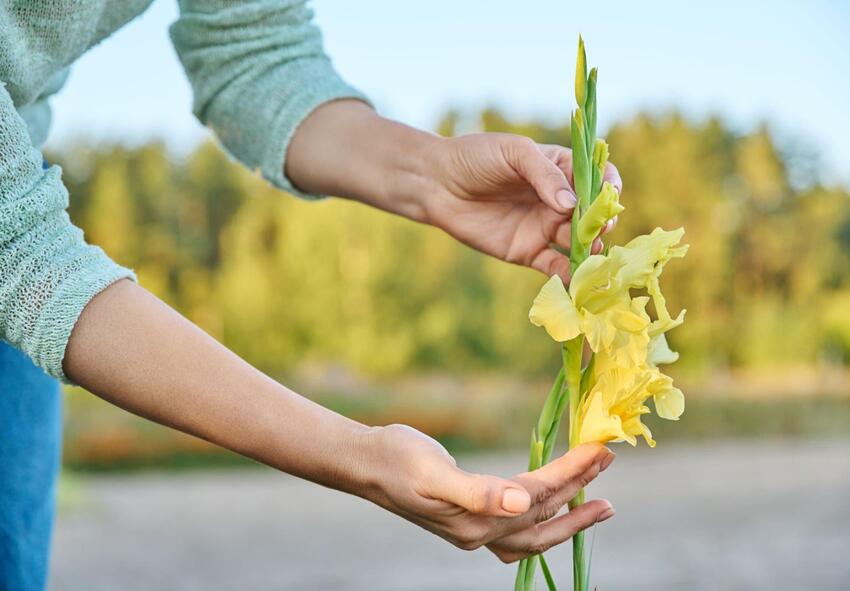
The segment titled “Key Aspects of Gladiolus Care” encompasses vital information regarding the nurturing of these flowers, encompassing watering, fertilizing, and pruning practices. The guide furnishes comprehensive instructions on how to properly care for the flowers, ensuring their sustained health and vibrancy throughout the entire growth cycle. By adhering to these guidelines, you can relish in the beauty of breathtaking gladiolus blooms year after year.
Mastering the Essentials of Gladiolus Care
Gladiolus bulbs should be planted in spring after the danger of frost has passed. Choose a sunny location with well-drained soil. The bulbs should be planted about 4 to 6 inches deep and 6 inches apart. Gladiolus plants require regular watering to thrive. Keep the soil consistently moist, but not waterlogged. Aim to provide about 1 inch of water per week, either through rainfall or manual watering. Avoid overhead watering to prevent diseases.
Gladiolus plants benefit from regular fertilization. Before planting, incorporate a balanced fertilizer into the soil. During the growing season, you can apply a slow-release granular fertilizer or a liquid fertilizer every two to three weeks to promote healthy growth and abundant blooms. As the gladiolus plants grow, their tall flower spikes may require staking to prevent them from bending or falling over. Install stakes or place supports near the plants at the time of planting to provide necessary support as they grow.
Applying a layer of organic mulch around the gladiolus plants helps to conserve moisture, suppress weed growth, and regulate soil temperature. Apply the mulch after the soil has warmed up and the plants have emerged. After the gladiolus flowers have bloomed and faded, it’s important to deadhead them by removing the spent flowers. This prevents the plants from expending energy on seed production and encourages more blooms.
In regions with cold winters, gladiolus bulbs are typically not winter hardy and need to be lifted and stored. Once the foliage has turned yellow and dried up after the first frost, carefully dig up the bulbs. Remove any remaining soil, cut off the foliage, and allow the bulbs to dry in a warm, well-ventilated area for a week or two. Store the bulbs in a cool, dry place until the next planting season.
Gladiolus plants can be susceptible to pests such as thrips and spider mites. Regularly inspect your plants for any signs of infestation and take appropriate measures to control them. Diseases like gladiolus rust and botrytis can also affect the plants. Ensure good air circulation, avoid overhead watering, and promptly remove any infected plant material to minimize the risk of disease.
By following these essential care tips, you can enjoy the beauty of gladiolus blooms and keep your plants healthy and thriving.
How to Plant Gladiolus

The planting of gladiolus bulbs is an uncomplicated procedure that can be carried out either in spring or fall. Commence by carefully choosing a location with soil that drains effectively and receives abundant sunlight. Dig a hole that is three times the height of the bulb and position it in the hole with the pointed end facing upwards. Ensure sufficient watering of the bulb, and proceed to cover it with soil.
Step-by-Step Guide to Planting Gladiolus for Striking Blooms
Here is a step-by-step guide to help you successfully plant gladiolus and enjoy their vibrant colors in your garden:
- Choose the Right Time: Gladiolus bulbs should be planted in the spring, after the danger of frost has passed and the soil has warmed up. This is typically around mid-spring, depending on your specific location.
- Select a Suitable Location: Gladiolus thrives in full sun, so choose a spot in your garden that receives at least 6 to 8 hours of direct sunlight each day. Ensure the soil is well-draining to prevent waterlogging, as gladiolus bulbs can rot in overly wet conditions.
- Prepare the Soil: Before planting, prepare the soil by removing any weeds or debris. Loosen the soil to a depth of around 12 to 15 inches (30 to 38 cm) using a garden fork or tiller. It’s also beneficial to incorporate organic matter, such as compost or well-rotted manure, to improve soil fertility and drainage.
- Dig the Planting Holes: Gladiolus bulbs should be planted 4 to 6 inches (10 to 15 cm) deep and spaced approximately 6 inches (15 cm) apart. Dig individual holes or trenches that are wide enough to accommodate the bulbs and their roots comfortably.
- Place the Bulbs: Position each gladiolus bulb with the pointed end facing upwards. This is where the shoots will emerge. If you’re unsure which end is the pointed side, plant the bulb horizontally, and it will find its way up. Space the bulbs according to the recommended spacing, ensuring they are not touching each other.
How to Care for Gladiolus
To properly nurture Gladiolus, it is crucial to provide the plant with a weekly watering routine and administer fertilization every other week throughout the growth phase. Gladiolus is a beautiful flowering plant known for its tall spikes of colorful blooms. Caring for gladiolus involves several key factors such as watering, feeding, and general maintenance.
Caring for Gladiolus: Watering, Feeding, and More
Here are some guidelines to help you care for your gladiolus plants:
Gladiolus plants require regular watering to keep the soil consistently moist, but not waterlogged. During dry periods, water deeply to ensure the moisture reaches the root zone. However, avoid overwatering, as it can cause bulb rot.
Applying a layer of organic mulch, such as straw or wood chips, around the base of the gladiolus plants can help retain soil moisture and suppress weed growth. Mulching also helps to moderate soil temperature.
Gladiolus plants benefit from regular feeding to promote healthy growth and abundant blooms. Before planting, incorporate well-rotted compost or aged manure into the soil. During the growing season, you can use a balanced fertilizer or a bloom-boosting fertilizer with higher phosphorus content to enhance flower production. Follow the instructions on the fertilizer packaging for application rates and frequency.
How to Prune Gladiolus
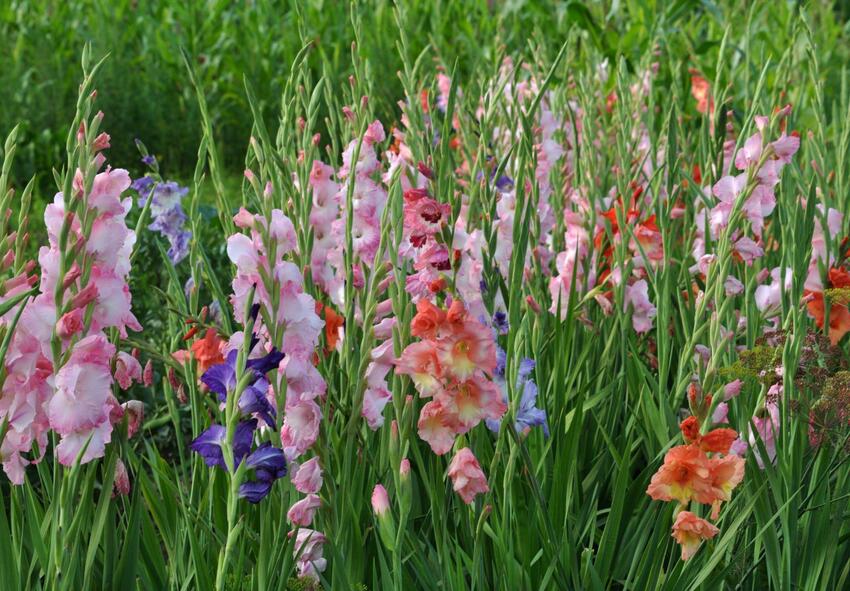
Pruning is a crucial aspect of gladiolus care, which ensures the plant’s healthy growth and aesthetic appeal. In addition to removing any dead or damaged leaves, it is also essential to trim or remove the spent flower spikes to encourage new growth. However, it is worth noting that pruning should be done with care and precision to avoid damaging the plant.
Pruning Gladiolus: Tips for Enhancing Growth and Aesthetic Appeal
Pruning gladiolus plants can indeed help enhance their growth and aesthetic appeal. Once gladiolus flowers have faded and wilted, it’s important to remove them promptly. This process, known as deadheading, prevents the plant from expending energy on seed production and encourages it to redirect its resources towards new growth.
After the gladiolus plant has finished blooming for the season and the flower stalks have withered and turned brown, you can trim them back. Use clean and sharp pruning shears or scissors to cut the stalks down to the base of the plant. This promotes tidiness and prevents the plant from wasting energy on maintaining dead foliage. Gladiolus leaves that are damaged, diseased, or turning yellow should be pruned away. This helps maintain the overall health of the plant and prevents the spread of any potential diseases. Cut the damaged leaves at the base of the plant, close to the soil surface.
How to Propagate Gladiolus
Propagating gladiolus is a straightforward process that can be done in the fall once the flowers have faded. It involves digging up the bulbs and separating the small corms from the larger ones. However, beyond this, it is crucial to ensure that the small corms are planted in a separate location and watered regularly until they begin to grow. This not only enhances their chances of survival but also promotes healthy growth.
Propagating Gladiolus: Techniques for Expanding Your Gladiolus Collection
Gladiolus plants grow from underground corms, which are bulb-like structures. Corm division is the most popular method for propagating gladiolus. Here’s how you can do it:
- Wait until the gladiolus plants have finished flowering and the foliage starts to turn yellow or brown.
- Carefully dig up the corms, taking care not to damage them.
- Separate the larger, healthy corms from the smaller ones, as the larger corms are more likely to produce strong, vigorous plants.
- Cut off any dead or diseased portions of the corms.
- Plant the larger corms in well-draining soil, spacing them a few inches apart and at a depth of about 4-6 inches (10-15 cm).
How to Overwinter Gladiolus
Preparing your gladiolus plants for the winter months is essential to maintain their health and promote continued blossoming. In addition to trimming the foliage and uprooting the bulbs, you may also want to contemplate implementing extra precautions, such as applying a layer of mulch, to shield the bulbs from the icy temperatures.
Overwintering Gladiolus: Preparing Your Plants for Cold Seasons
In regions with cold winters, it’s necessary to take certain steps to overwinter gladiolus bulbs and ensure their survival until the next growing season. Here’s a guide on how to prepare your gladiolus plants for the cold seasons:
- Timing: Before the first frost in your area, typically in late fall, it’s essential to start preparing your gladiolus plants for overwintering.
- Digging up the bulbs: Use a garden fork or spade to carefully dig up the gladiolus bulbs from the ground. Start digging at least six inches away from the base of the plant to avoid damaging the bulbs.
- Cleaning the bulbs: After removing the bulbs from the ground, gently remove the soil and any remaining foliage attached to them. It’s important to handle the bulbs delicately to avoid any damage.
- Bulb inspection: Examine each bulb for any signs of damage or disease. Discard any bulbs that appear soft, rotting, or damaged, as they may not survive the winter. Only select healthy and firm bulbs for storage.
- Trimming: Once the bulbs are clean, trim the foliage back to about two inches above the bulbs. This helps prevent the bulbs from drying out during storage.
- Drying: Allow the bulbs to dry for about one to two weeks in a cool and dry location. This drying period helps to further reduce the risk of rot and fungal infections during storage.
- Storage: Choose a suitable storage location that is cool, dry, and well-ventilated. Ideally, the temperature should be between 35°F (2°C) and 50°F (10°C). Place the gladiolus bulbs in a mesh bag, paper bag, or cardboard box with good airflow. Avoid using plastic bags, as they can trap moisture and promote rot.
Gladiolus Blooming Times
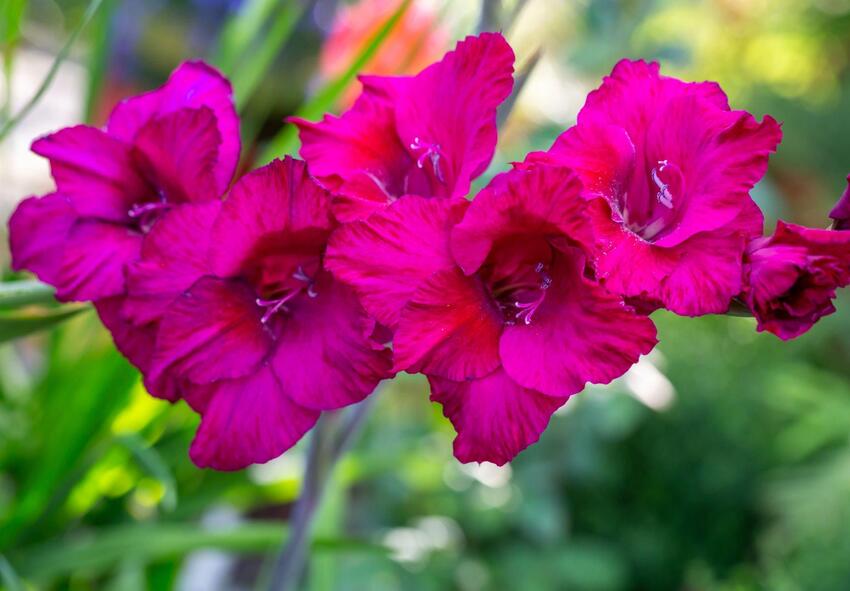
Gladiolus blooms in the summer and fall, with the specific blooming time varying depending on the variety. While large-flowering gladioli typically bloom in mid-summer, miniature and ruffled varieties bloom later in the season. It is also worth noting that the blooming time can be influenced by various factors such as planting time and soil conditions.
Discovering When Gladiolus Blooms for Captivating Displays
Understanding when gladiolus blooms can help you achieve captivating displays in your garden. Generally, the blooming time varies depending on the variety, with large-flowering gladioli typically blooming in mid-summer, while miniature and ruffled varieties bloom later in the season. However, it is also important to factor in other elements such as planting time and soil conditions to optimize blooming time.
Essential Considerations for Gladiolus
Key factors to keep in mind when cultivating Gladiolus involve careful choices of soil and location, consistent fertilization, and periodic pruning. It is crucial to ensure that you have the appropriate tools and materials readily available, including a shovel, gloves, fertilizer, and well-drained soil. By providing the necessary care and attention, Gladiolus plants can flourish for many years, showcasing a breathtaking exhibition of vibrant hues and graceful beauty.
What May Be Needed? Tools and Supplies for Successful Gladiolus Cultivation
For successful gladiolus planting, it is vital to ensure you possess the necessary equipment and materials. These encompass a shovel, gloves, fertilizer, and soil with excellent drainage. Additionally, you might contemplate acquiring a trowel, compost, and mulch to further enhance the well-being of your gladiolus. A trowel aids in excavating small planting holes, while compost enriches the soil and supplies vital nutrients. Meanwhile, mulch serves the purpose of retaining moisture in the soil, particularly advantageous during periods of drought.
Selecting the Right Soil for Gladiolus
To ensure optimal growth of Gladiolus, it is crucial to have soil that drains effectively. This entails identifying a site with loose and well-aerated soil. Alongside these attributes, selecting soil that is abundant in organic matter holds great significance as it enhances soil structure and supplies vital nutrients to the plant. To incorporate organic matter into your soil, consider blending in compost or well-decomposed manure.
Best Places to Plant Gladiolus
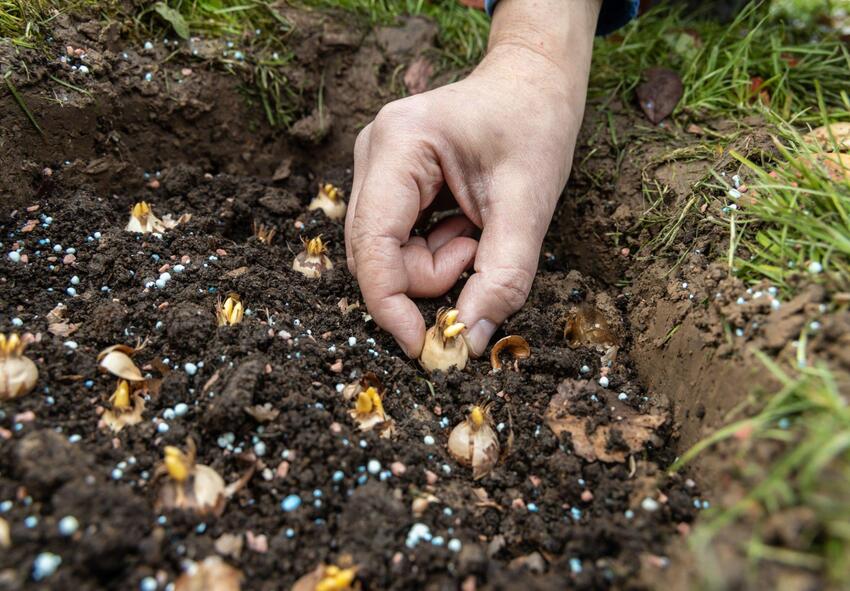
For optimal growth, Gladiolus thrives in a sun-drenched spot with soil that drains effectively. It is vital to steer clear of areas prone to stagnant water, as this can lead to bulb decay. Excellent locations for planting Gladiolus encompass sunny garden beds, alongside fences or walls, or in containers on a patio or balcony. Another option worth considering is to plant Gladiolus in raised beds, as this can enhance soil drainage and create an ideal growing environment for the plant.
Finding the Ideal Location for Gladiolus to Thrive
To ensure optimal growth of Gladiolus, it is crucial to choose a planting location abundant in direct sunlight. Additionally, the soil should possess excellent drainage, hence it is important to avoid areas with stagnant water. Apart from these considerations, it is worth evaluating the microclimate of the chosen spot. Gladiolus can be sensitive to cold temperatures, therefore it is advisable to refrain from planting them in areas prone to frost or cold drafts. Conversely, selecting sheltered areas that offer protection against strong winds can help prevent damage to the plants.
Fertilizer for Gladiolus
Gladiolus requires regular fertilization to grow properly. Choose a fertilizer that is high in phosphorus, which promotes healthy root growth and flower production.
Choosing and Using Fertilizer for Healthy Gladiolus Growth
For optimal development of your gladiolus plants, it is vital to implement regular fertilization. When choosing a fertilizer, opt for one with a high phosphorus content. This nutrient plays a pivotal role in fostering robust root growth and enhancing flower production.
In addition to utilizing a phosphorus-rich fertilizer, there are additional measures you can employ to promote the growth of your gladiolus. For instance, incorporating organic matter into the soil before planting can enhance soil structure and provide supplementary nutrients to your plants. Furthermore, applying a layer of mulch around your gladiolus plants helps to conserve moisture and suppress weed growth, enabling your plants to channel their energy towards flourishing and abundant flower production.
Where to Buy Gladiolus
If you’re looking to purchase gladiolus bulbs, there are many different options available to you. Online retailers offer a wide selection of bulbs, which can be a convenient option for those who prefer to shop from home. Local garden centers and nurseries are another great source for gladiolus bulbs, and they may be able to offer advice on which varieties are best suited to your local growing conditions.No matter where you choose to purchase your bulbs, be sure to carefully inspect them before planting to ensure that they are healthy and free from disease or damage. With the right care and attention, your gladiolus plants will reward you with a beautiful display of flowers come blooming season.
Frequently Asked Questions (FAQs) about Gladiolus
1. What are Gladiolus and why should I consider growing them in my garden?
Gladiolus, commonly known as sword lilies, are a stunning and vibrant addition to any garden. These tall, elegant flowers come in a wide range of colors and can grow up to 6 feet tall, making them a striking focal point. They are known for their beautiful, sword-shaped foliage and spiky blooms. Gladiolus are relatively easy to grow and can be a great choice for both beginners and experienced gardeners. They also make fantastic cut flowers, adding beauty and elegance to your floral arrangements.
2. When is the best time to plant Gladiolus bulbs?
Gladiolus bulbs should be planted in the spring after the last frost has passed. This typically falls between late March and early May, depending on your location. Planting at this time ensures that the soil is warm enough for proper root development and encourages strong growth during the growing season. Be sure to choose a sunny location with well-drained soil to promote healthy Gladiolus growth.
3. How do I care for Holland Gladiolus plants during the growing season?
During the growing season, it’s essential to keep your Gladiolus plants well-watered, especially during dry spells. Provide support for tall varieties to prevent them from bending or toppling over. Regularly deadhead blooms to encourage continuous flowering. Fertilize your Gladiolus every 2-4 weeks with a balanced fertilizer to promote robust growth and vibrant blooms. Mulching can help conserve moisture and control weeds around your Gladiolus bed.
4. Can Gladiolus bulbs be ordered from your online store?
Yes, you can! Our online store offers a wide selection of Gladiolus plants, including different varieties and colors. We take pride in providing top-quality plants that are carefully cultivated and shipped with care to ensure they reach you in perfect condition. Visit our online store to explore our collection and place your order for a delightful addition to your home or garden.
5. Are Gladiolus susceptible to pests or diseases, and how can I protect them?
While Gladiolus are generally hardy plants, they can be susceptible to common garden pests like aphids and thrips. To protect your Gladiolus, inspect them regularly for signs of infestation, and use appropriate organic or chemical treatments if needed. Additionally, ensure good air circulation to prevent fungal diseases. Proper watering, spacing, and soil drainage will help maintain the overall health of your Gladiolus plants and reduce the risk of diseases.
Published: 20.06.2023
